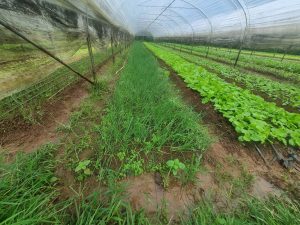GSF › Forums › Mang Den Forum › Mang Den High-Tech Agriculture and Korean Vegetable Development Project
- This topic is empty.
-
AuthorPosts
-
2024-07-29 at 8:32 am #213
Do Kyong Kim
KeymasterFeasibility Study Report
1. Introduction
1.1 Project Overview The Mang Den High-Tech Agriculture and Korean Vegetable Development Project aims to utilize advanced agricultural technologies to cultivate Korean vegetables in Mang Den, a region in the Central Highlands of Vietnam. This project seeks to generate economic benefits, conserve the environment, and improve the living standards of the local community.
1.2 Objectives and Goals
- Purpose: To achieve economic benefits, environmental conservation, and improved living standards through high-tech agriculture and the cultivation of Korean vegetables in the Mang Den region.
- Goals:
- Identify suitable Korean vegetable varieties
- Assess the environmental and economic feasibility of introducing advanced agricultural technologies
- Develop cultivation and harvest plans
- Establish collaboration methods with the local community
2. Research Methods
2.1 Field Survey
- Survey Area: Key areas within Mang Den, encompassing various soil types and climate conditions


- Survey Methods:
- Direct observation through field visits
- Soil sampling and analysis
- Interviews with local farmers and experts
- Biodiversity assessment
2.2 Literature Review
- Review of existing studies and literature
- Analysis of high-tech agriculture and Korean vegetable cultivation cases in similar regions
3. Korean Vegetable Varieties and Characteristics
3.1 Napa Cabbage (Brassica rapa subsp. pekinensis)
- Characteristics: Adapts well to cool climates and grows best in fertile soil.
- Uses: Primarily used for making kimchi and in various dishes.
- Suitability:
- Ecological: Harmonizes with the local ecosystem and contributes to biodiversity enhancement
- Agricultural: Easy to manage and can be integrated into local agricultural systems
- Economic: Contributes to high-value product production such as kimchi
3.2 Radish (Raphanus sativus)
- Characteristics: Adapts well to various climate conditions and grows best in well-drained soil.
- Uses: Used in kimchi, pickles, salads, and various dishes.
- Suitability:
- Ecological: Adapts to local climates, maintaining ecological stability
- Agricultural: Increases agricultural productivity and income
- Economic: Generates revenue through the production of kimchi and other value-added products
4. Field Survey Activities
4.1 Survey Objectives
- Identify suitable Korean vegetable varieties for cultivation in Mang Den
- Assess environmental conditions and soil suitability for different species
- Gather insights and recommendations through collaboration with local farmers and experts
4.2 Key Activities
- Site Visits: Assess soil conditions, water availability, and sunlight exposure by visiting potential planting sites
- Soil Testing: Collect soil samples from various locations for pH, fertility, and texture analysis
- Interviews and Workshops: Conduct interviews and workshops with local farmers, agricultural experts, and forestry officials to understand current practices, challenges, and opportunities
- Biodiversity Assessment: Document existing flora and fauna to ensure new plantations complement the local ecosystem
5. Survey Results
5.1 Napa Cabbage
- Results: Suitable for fertile, well-drained soils and cool climates. Local farmers show high interest in Napa cabbage cultivation.
5.2 Radish
- Results: Adapts well to various soil conditions and climates. Radish has high quality and significant export potential.
6. Economic Analysis
6.1 Investment Costs
- Analysis of initial investment costs, including soil preparation, seed purchase, agricultural equipment, and labor
- Evaluation of cultivation and management costs, as well as harvesting and processing expenses
6.2 Revenue Projections
- Revenue projections based on expected yields and market prices
- Analysis of demand in export and domestic markets
6.3 Economic Benefits
- Increased income for farmers
- Stimulation of the local economy
- Development of related industries (kimchi manufacturing, food processing, etc.)
7. Environmental Impact
7.1 Ecosystem Conservation
- Evaluation of the positive impacts of Korean vegetable cultivation on the ecosystem
- Analysis of soil erosion prevention and biodiversity enhancement effects
7.2 Sustainability
- Development of sustainable agricultural practices
- Introduction of environmentally friendly cultivation and management techniques
8. Social Impact
8.1 Community Participation
- Development of methods for local community participation and cooperation
- Creation of education and training programs
8.2 Improvement of Living Standards
- Job creation through Korean vegetable cultivation
- Increase in local residents’ income and improvement of living standards
9. Conclusion and Recommendations
9.1 Conclusion Field surveys and analysis indicate that Mang Den is a suitable area for high-tech agriculture and Korean vegetable cultivation, offering significant economic, environmental, and social benefits.
9.2 Recommendations
- Napa Cabbage: Expand cultivation areas and develop value-added products to meet market demand.
- Radish: Develop support programs for cultivation and promote exports to increase local incomes.
- Education and Training: Provide education and training programs related to sustainable agricultural practices to local residents.
Attachment
Attachments:
You must be logged in to view attached files. -
AuthorPosts
- You must be logged in to reply to this topic.
